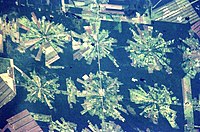
Photo from wikipedia
This study was carried out in the Bucegi Natural Park, a protected area of the Romanian Carpathians. It aims at documenting the potential sensitivity of six widespread Natura 2000 habitat… Click to show full abstract
This study was carried out in the Bucegi Natural Park, a protected area of the Romanian Carpathians. It aims at documenting the potential sensitivity of six widespread Natura 2000 habitat types and of all plants with conservative value (200 taxa) in the mountain area, to the changes in temperature and humidity, predicted for this century. Regional expert knowledge and environmental indicator values were considered in assessing the potential habitat’s sensitivity. The results support the evidence that sensitivity to temperature may be potentially higher for habitats at alpine and subalpine levels (bushes and grasslands) and medium for forest habitats. Sensitivity to moisture was detected as potentially high for forest habitats and as medium for bushes and grasslands at high mountain elevation. Microthermophilic plants have shown a greater share (76-79%) in alpine and subalpine communities, and the hydrophilic plants (86-96%) in forest communities. About 80% of plants of conservation value (microthermophilic or hydrophilic plants) may be potentially sensitive to predicted warming and drought and 44% of them (microthermophilic and hydrophilic plants) to the changes of both parameters. Climate scenarios (2011-2100) and sensitivity maps (Sat – image interpretation with GIS for the whole mountain area) are included.
Journal Title: Notulae Botanicae Horti Agrobotanici Cluj-napoca
Year Published: 2020
Link to full text (if available)
Share on Social Media: Sign Up to like & get
recommendations!